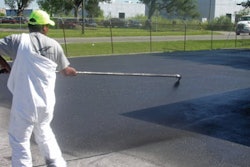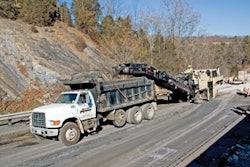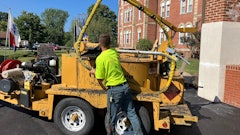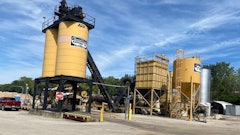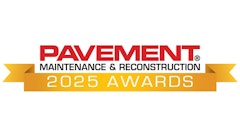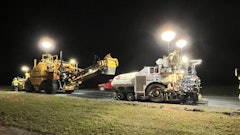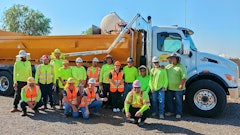By Michael Groh
Which of the following statements best describes your firm's relationship with your customer base?
1. I depend on my customer to help me achieve my personal and corporate financial goals.
2. My customer depends on me and my firm to help them effectively manage their pavement assets.
If statement #1 characterizes your approach in the pavement maintenance industry there is no reason to continue to read this article. I would suggest that you use your time to explore alternate careers as your current business model is seriously flawed for long-term success.
Agreement with statement #2 indicates that you and your firm are committed to developing and maintaining a long-term relationship with your customer base. One way to develop an interdependent relationship with your clients is to offer them a new approach to managing their pavement needs. Over the last three decades I have had the opportunity to work with a variety of facility and property managers throughout the United States and I continue to be amazed at how often maintaining this important property asset is often overlooked. Pavement maintenance is frequently a low priority that is woefully underfunded.
Here's a common situation I am sure you have encountered: A property manager gets a call regarding a pothole in the third aisle of the south parking lot. She contacts the maintenance personnel to place a barricade over the pothole to keep people from being injured or damaging their car. The barricade becomes a semi-permanent fixture in the south lot until someone has time to place temporary patch material in the hole. So often the approach is to apply a short-term "fix" that does not address the causes of the failure. After all, "it is just a parking lot" seems to be the sentiments of many property owners.
This scenario is certainly oversimplified, but unfortunately maintaining a parking lot in a proactive fashion is more the exception than the rule. When potholes begin to interconnect and the lot starts to look like a strip mining operation, it is often only then that budgets are submitted for repair of the pavement.
There are many reasons why maintaining a parking lot is not a priority. I've found that the primary reason is that managers often are not aware of the true value of their pavement asset. It is not uncommon that the replacement value of a hot mix asphalt parking lot can have a value in excess of $1 million based on a typical cost to install a parking stall with hot mix asphalt at $1,500 - $2,000 per stall.
The value of this asset is such that if the maintenance is overlooked for an extended period of time, the cost to replace it is often prohibitive in financial terms and the amount of "downtime" required to replace the lot is usually substantial. The property manager is then faced with using a "band-aid" approach that only exacerbates the problem. A "band-aided lot" is probably not the best first impression a company wants its customers and employees to have.
A potential solution to this reoccurring problem is to work with your client to develop an inventory of the current conditions and a long-term strategy to manage the pavement. This process is commonly referred to as a Pavement Management Program.
There are numerous interpretations of what elements comprise a Pavement Management Program (PMP). The earlier a PMP is begun, the greater the benefits the owner will experience. The key activities that comprise a PMP are:
- Pavement inventory/assessment
- Plans and specifications
- Tracking of maintenance and rehabilitation activities
Inventory Assessment
In order to properly execute a cost-effective management program for pavements, it is important to have a comprehensive inventory of the facility's pavements. Prior to the fieldwork, the pavement area should be categorized into various sections by type of use, location, or condition. These various sections allow for more detail to be noted and will assist in the budgeting process.
During the assessment, the condition of the pavement is rated numerically using a variety of methodologies. In addition to rating the pavement condition, consideration should also be given to adjacent elements such as curbs and sidewalks, as well as drainage structures. It is imperative that during the assessment, issues pertaining to pedestrian access be taken into consideration. This is an excellent time to identify any safety items requiring immediate repair.
The next step is to generate a report describing the original pavement construction and its current condition by section. The condition rating and use of the pavement will assist in determining the appropriate rehabilitation requirements or maintenance activity, and the year in which it should be completed. This information is then converted into and five-year budget, on a year-by-year basis with reinspections every other year. (Updates become necessary based on changes in the pavement condition, local construction cost variability, and funding levels.) A well-documented condition summary, combined with accurate cost estimates, is an effective tool in obtaining funding and reducing overall costs to maintain pavements.
Plans and specifications
The next step is to initiate the work outlined in the report. Over the years we've received phone calls from owners who have called three contractors to "give them a bid to fix the lot." At best, their efforts result in trying to compare proposals that offer various construction procedures that are not comparable, including significant variations in cost.
In some situations, the contractor is asking them to spend an amount in the low six figures based upon a one-line proposal that reads "Clean, patch, and pave the south parking lot," fully expecting an owner to commit large sums of money based on little information. Either situation is a lose-lose proposition for the facility manager.
To maximize an owner's budget, a detailed set of plans and specifications must be developed. Owners should avoid accepting lump sum proposals, as they provide no flexibility in making adjustments in the field based on conditions encountered or changes in budgets. The scope of work must be clearly defined in the specifications, utilizing industry standards for materials and installation.
The rehabilitation plan must show limits of the work and any applicable pavement design cross-sections to support information contained in the specifications. The proposal form should reflect the scope of work with applicable pay quantities and units of measurement that will be used. The detailed proposal form allows owners to select the most responsible bidder, which is not always the lowest bidder.
Track Maintenance & Rehab
An often overlooked aspect of the PMP is creating a document, updated annually, that quantifies the location of the work that was completed and a detailed cost of the work.
This document when contrasted with the proposed work defined within the PMP will underscore the accuracy of the original budget and serve as a tool when updating future budgets. Over the long term it will also benefit the owner in calculating the life cycle costs of the work that has been performed.
Contractor-initiated PMPs
The benefit of a well-executed PMP is that the serviceable life of a properly constructed pavement can be extended beyond its anticipated life cycle. The total expenditures on the pavement will be significantly less in a proactive approach, and the serviceability of the pavement will be better. The owner will place a high value on a pavement that is safer, has less maintenance downtime, and is more aesthetically pleasing.
Do not underestimate the time and energy that developing a PMP for your client will take. It is your responsibility to explain to your client the benefits of a PMP. Remember, not all of your client's will appreciate the value of what is being offered and your task is to clearly define the PMP and any costs associated with the service. How you choose to pass on the costs of this service is a decision that only you can make. I have seen contractors offering variations of a PMP at no cost to their client and I would urge you to not to undertake this approach as it is difficult to assign a value to a service that has no cost to the end user. I would suggest charging an annual fee for inspection services plus a separate cost for generating specs for bidding purposes.
After you have reached an agreement with your client on the level of service and the associated costs, invest the appropriate time and energy to generate a substantive report that is consistent with your mutually agreed upon objectives. Generating a PMP on a fee basis is not a guarantee of getting all of your client's pavement maintenance and rehabilitation business, but a well-executed PMP will allow you access to your client's short- and long-term objectives. It also will allow you to demonstrate your pavement maintenance knowledge on a regular basis.
The owner will place a high value on your contributions and will be more inclined to work with a "value" oriented contractor, such as your firm, rather than a "price" oriented firm that does not appreciate the long-term needs of the operation.
Distinguish yourself and your firm in your market area from your competitors by discussing the importance of a site specific PMP and offering this service to those who appreciate the long term value.
Michael Groh is a senior consultant with Benchmark Inc., a pavement and roof consulting firm with offices located in Cedar Rapids, IA, and Elm Grove, WI. He has more than 24 years of experience in the pavement industry and is a frequent speaker at National Pavement Expo and at University of Wisconsin - Madison pavement seminars throughout the United States.




